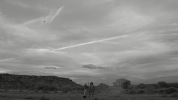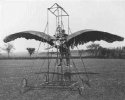Travis Taylor and Erik Bard are claiming that a fly would be a blurry blob. But would it?
50° FOV seems about right. On my Canon 7D with a 17-50mm zoom and the built-in 1.6x crop, that needs about 22mm.

I think this would be a reasonable camera setup for comparison. What if I duplicate this image, how far away would the fly be? Would it be in focus?

I set up a test with drywall screws turned head on to the camera as rough analogs of flies. The camera is focused at infinity

To be most conservative I used the widest aperture available f/2.8

As expected, flies close to the camera are very blurry. But blurrier than the SWR fly? Here's what the images look like at the same scale.

Narrowing the comparison to 5,6,7, and 8 feet:

And if we use the higher resolution version they accidentally released in the trailer:

The amount of blur seems consistent with something at 7-8 feet.
That was at the widest aperture. At a narrower f/5.6, the blurriness is similar around 5-6 feet.

(Note my images are raw, so have pixel-level grain, but no compression artifacts. The SWR teaser fly is compressed, so the blur gets jaggier.
So it does not seem like there's any real obstacle to the fly being a few feet in front of the camera.




